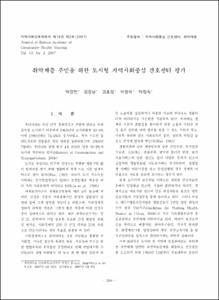취약계층 주민을 위한 도시형 지역사회중심 간호센터의 평가
- Keimyung Author(s)
- Park, Kyung Min; Kim, Chong Nam; Koh, Hyo Jung; Park, Yeong Sook; Park, Jeong Sook
- Department
- Dept. of Nursing (간호학)
- Journal Title
- 지역사회간호학회지
- Issued Date
- 2007
- Volume
- 18
- Issue
- 2
- Abstract
- Purpose: The purpose of this study was to
evaluate achievements of a community health
center for vulnerable population in urban areas
and to find out its strength and weakness.
Method: This evaluative study employed system
theories and analytic techniques. Results: The
purpose of improving vulnerable population’s
health-related self-care abilities adequately met
the operation of programs. This center
maintained close connection to a nursing college
as a information resource. The subjects'
satisfaction was high because team members
who visited them were faithful and there were
face-to-face contact, sufficient time set,
closeness and resourcefulness. There were needs
for regular meetings to discuss overall matters
in organizing the program and to improve
management skills. The mean score of health
promotion lifestyle was 2.23 on a 4 point scale.
This score indicates what in higher than
vulnerable people in other communities.
Conclusions: Community-based nursing centers
for vulnerable population in urban areas should
be developed as support organizations and
community network.
본 연구는 2006년도 1월부터 12월 말까지 취약계층
주민을 위한 도시형 지역사회중심 간호센터를 평가하기
위해 간호센터의 역할에 대해 투입된 노력, 과정 및 성
과를 분석한 서술적 연구이며 결과는 다음과 같다.
1. 구조평가
투입요소 중 만성질환을 가진 취약계층 주민인 노인,
장애인, 소년소녀가장세대, 한 부모가족세대, 조손세대를
대상으로 보건, 의료 및 복지서비스를 통합적으로 제공
하여 자가 관리 능력향상 이라는 목적과 1차보건 의료의
구체적인 내용이 목표로 설정되어 있어 매우 합리적이다.
채용된 인력의 교육은 대학과 연계되어 있어 질적으로
높은 교육을 지속적으로 받고 있어 긍정적으로 평가되었
다. 조직은 운영위원회, 목회간호사, 간호대학생, 의과대
학생, 복지기관 소속 물리치료사로 다양한 인력 구성으
로 긍정적으로 평가되었음 순수한 민간 후원금으로 이루
어진 예산에 적합한 상황이었다. 센터의 예산은 인건비
가 50%를 차지하였으며 실제 운영비는 부족한 실정이므
로 지역사회와의 연계 개발이 더 이루어지는 것이 필요
하다.
2. 과정평가
대상자에 대한 사정이 구체적으로 이루어지고 있으며,
대상자와의 친밀도가 높아서 가정환경과 교육수준 등 구
체적인 사항 파악으로 대상자에 적절한 보건교육 제공이
가능하다. 목회간호사의 사명감, 면대면 접촉, 충분한 시
간배정, 접근성, 지속적인 관리, 자원연계가 체계적으로
이루어져 대상자의 만족도가 높다. 운영위원회와 실무자
간 사업수행 방향에 대한 의견수렴과정에 대한 구체적인
논의가 정기적 이루어짐이 필요하며, 재정 부족, 상담과
건강 사정에 대한 자료의 문서화가 수작업으로만 이루어
져 관리상 어려운 점을 개선할 필요가 있다.
3. 성과평가
건강증진행위 수행정도는 평균은 2.23점이었으며, 세
대별 건강증진행위는 장애인 가족 2.27점, 불완전가족
2.25점, 노인세대 2.21점의 순이었으며 유의한 차이는 없었으며, 타 연구에서 보고된 취약계층 건강증진행위
수행 점수보다 높게 평가되었다.
- Alternative Title
- Evaluation of Community Health Center for Vulnerable Population in Urban Areas
- Publisher
- College of Nursing
- Citation
- 박경민 et al. (2007). 취약계층 주민을 위한 도시형 지역사회중심 간호센터의 평가. 지역사회간호학회지, 18(2), 266–275. doi: Purpose: The purpose of this study was to evaluate achievements of a community health center for vulnerable population in urban areas and to find out its strength and weakness.
Method: This evaluative study employed system theories and analytic techniques. Results: The purpose of improving vulnerable population’s health-related self-care abilities adequately met the operation of programs. This center maintained close connection to a nursing college as a information resource. The subjects’ satisfaction was high because team members who visited them were faithful and there were face-to-face contact, sufficient time set, closeness and resourcefulness. There were needs for regular meetings to discuss overall matters in organizing the program and to improve management skills. The mean score of healthpromotion lifestyle was 2.23 on a 4 point scale. This score indicates what in higher than vulnerable people in other communities.
Conclusions: Community-based nursing centers for vulnerable population in urban areas should be developed as support organizations and community network.
- Type
- Article
- ISSN
- 1225-9594
- Appears in Collections:
- 2. College of Nursing (간호대학) > Dept. of Nursing (간호학)
- 파일 목록
-
-
Download
 oak-bbb-05042.pdf
기타 데이터 / 305.19 kB / Adobe PDF
oak-bbb-05042.pdf
기타 데이터 / 305.19 kB / Adobe PDF
-
Items in Repository are protected by copyright, with all rights reserved, unless otherwise indicated.